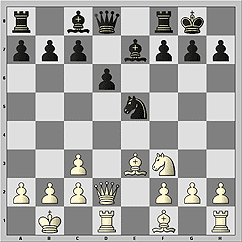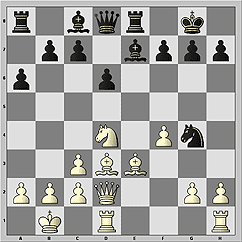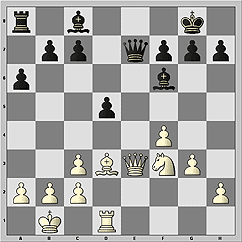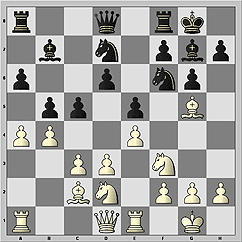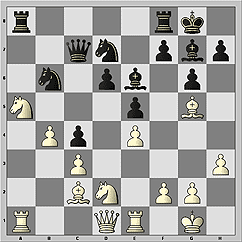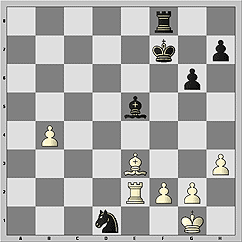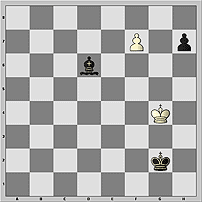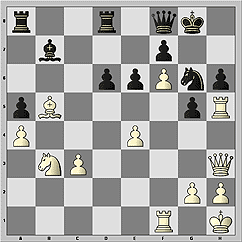 | Последние турниры |
Чемпионат России
СуперФинал

02.12.2006
Суперфинал чемпионата России проходит в Москве, в ЦДШ им. М.М.Ботвинника со 2 по 15 декабря при 12 участниках по круговой системе.
Крамник - Fritz

25.11.2006
С 25 ноября по 5 декабря в Бонне чемпион мира Владимир Крамник сыграет матч из 6 партий с программой Deep Fritz. В случае победы Крамник получит 1 миллион долларов, тем самым удвоив свой стартовый гонорар ($500000).
Мемориал Таля

5.11.2006
В Москве с 5 по 19 ноября проходил Мемориал Таля, в программе которого супертурнир 20-й категории и выдающийся по составу блицтурнир. Призовой фонд каждого состязания - 100.000 долларов.
Топалов - Крамник

23.09.2006
После того как "основное время" не выявило победителя (счет 6:6), 13 октября соперники сыграли 4 дополнительных поединка с укороченным контролем времени.
Томск. Высшая лига

2.09.2006
Со 2 по 11 сентября Томск принимает Высшую лигу чемпионата России 2006 года. В турнире участвуют 58 шахматистов - как получившие персональные приглашения, так и победившие в отборочных состязаниях.
Майнц

17.08.2006
В последние годы фестиваль в Майнце вслед за "Амбер-турниром" стал центром легких шахматных жанров. Наряду с массовыми ристалищами традиционно проходят чемпионские дуэли.
Россия - Китай

10.08.2006
С 10 по 20 августа в Китае проходит товарищеский матч сборных России и Китая. В нынешнем поединке как мужчины, так и женщины соревнуются на пяти досках по шевенингенской системе в два круга.
Все материалы
ChessPro

|
|

|
|
 |
Сергей ШИПОВ,
гроссмейстер |
Last Round: Bulgarian Fiesta |
I’m very glad for Topalov’s fans. I’m really glad for Bulgaria! It’s always a pleasure to witness a grandiose triumph of your compatriot, to read thousands of panegyric comments from allover the world, to be proud of your country. As far as I know there are not so many famous sportsmen in Bulgaria. It’s not like in the US or in Russia where fans are literally spoiled by sport thriumphs of their compatriots. Bulgarians honor Khristo Stoichkov and the soccer team of 1994, their weight-lifters, the high-jumper Stefka Kostadinova and… I don’t know anybody else.
But I know for sure that now this small Balkan country can proud itself of a bunch of world chess champions. Antoaneta Stefanova is a women world champion. Recently Liuben Spassov won the senior title. Finally Veselin Topalov becomes the real gem of this collection. No doubt that Bulgarian boys and girls will go in for chess with greater enthusiasm now. They have the example to follow. They know the way! So if in 5-10-year time we can expect the surge of the Bulgarian waive in chess world.
Before analyzing the games of the last round I want to say a couple of words about every player.
TOPALOV. There is nothing to add. A brilliant and a deserved success! Those, who analyzed Veselin’s games, would agree that his result could have been even better. So the champion still has some potential!
ANAND. The Indian GM staged an average performance. He visibly lacked drive, energy, ambitions. Maybe Vishy got sick of the victories. It’s pretty hard to make himself try hard when the motivation is low. It’s a usual problem of chess veterans. In San Luis Anand only confirmed his high class, which nobody questioned anyway. I can also point out his excellent opening preparation.
SVIDLER. Peter keeps progressing. I have a feeling, that many foreign experts underestimated him. And they were wrong! Unfortunately, Svidler is not invited to super tournament very often. Once again I can’t see his name in the list of participants of Wijk-aan-Zee 2006. Judge it yourself whether it’s right or not …
MOROZEVICH. He played in his usual style and always fought till the very end. The spectators were happy with his play. Alexander’s result is in line with his style.
LEKO. The main disappointment. Everyone expected him to be one of the main contenders. Of course, a vexing defeat in the first round against a future champion was a had blow. Probably, Peter just wanted to be the first too much but failed to cope with the pressure…
ADAMS. He didn’t surprise us. Absolutely! Michael is not ready to conquer chess heights. He has talent (a peculiar talent!), but this is not enough: one should have a trainer, go in for sports, dream about high goals etc…
KASIMDZHANOV. Despite several defeats, Rustam deserves some good words. The progress in his game and preparation is obvious. Rustam is short of just a couple years of regular participation in the super tournaments. He lacks the experience of playing on elite level, the might-have-been match versus Kasparov. It’s hard to succeed without this background.
POLGAR. A brilliant chess Queen was out of form. Polgar can play better which she previously demonstrated on many occasions. Her opening preparation also let her down. Anyway Judit is the best!
The etiquette ruled in the main game. The King and the Queen were mutually courteous and obliging.
Queen’s Indian E15
Veselin TOPALOV (BUL) – Judit POLGAR (HUN)
1.d4 Nf6 2.c4 e6 3.Nf3 b6 4.g3 Ba6 5.b3 Bb4+ 6.Bd2 Be7 7.Bg2 c6 8.Bc3 d5 9.Nbd2 Nbd7 10.0–0 0–0 11.Re1 Bb7.
12.e4 dxe4 13.Ne5 c5 14.Nxe4 Nxe4 15.Bxe4 Bxe4 16.Rxe4 Nxe5 17.dxe5 Qxd1+ 18.Rxd1 Rfd8.
Draw.
The game of the prize-winners wasn’t long either. I believe that Peter wanted to offer a real fight and win the second place, but in the course of the game he felt run out of steam and didn’t make himself continue.
Petroff Defense C42
Peter SVIDLER (RUS) – Vishwanatan ANAND (IND)
1.e4 e5 2.Nf3 Nf6 3.Nxe5 d6 4.Nf3 Nxe4 5.Nc3 Nxc3 6.dxc3 Be7 7.Be3 Nc6 8.Qd2 0–0 9.0–0–0 Ne5 10.Kb1. A well-known opening position of the Petroff defense with opposite wing castling. Such setup doesn’t lead to a sharp play automatically. Since the center is wide open it’s difficult to organize an attack. In such positions everything should be prepared through the center.
10...Re8. A new move order. Popular 10...a6 has an unpleasant psychological aftertaste – 11.Be2 Be6 12.Nd4 Nc4 13.Qd3 Nxe3 14.Nxe6 fxe6 15.Qxe3 e5 16.Bd3 c6 17.h4 Rf6 18.g3 d5 19.Qxe5 Rxf2 20.Rhf1 Rf6 21.Qh5 g6 22.Qe2 Qd6 23.h5, and White launched a winning attack (Anand – Kramnik, Monte Carlo, 2005.
The experiment of the leader of French chess have followers so far: 10...Bf6!? 11.Nd4 Nc6 12.h3 Nxd4 13.cxd4 Bf5 14.Bd3 Bxd3 15.Qxd3 Re8 16.Rhe1 Qd7 17.g4 g6 18.g5 Bg7 19.h4 Qg4 20.Rh1 Qe4 21.Qf1 c5 22.dxc5 dxc5 23.Qd3, and a draw was agreed in this equal position (Naiditsch – Bacrot, Dortmund, 2005). 10...Be6 was also played.
11.Nd4 a6. It’s very important to check out 11...c5 here, as sharp actions do not work – 12.Nb5 (12.Ne2 Ng4!; 12.Nf3!?) 12...Be6 13.Nxd6? Bxd6 14.Qxd6 Qa5, and there is no defense against two threats Qa5xa2 and Ra8-d8. To finish the line of White’s cooperative play I can “recommend” 15.Qxe5? Bxa2+ and capture on e5.
I think Vishy didn’t even look at 11...c5. He wasn’t going to take any risks and probably understood that Peter wasn’t in the fighting mood too.
12.f4 Ng4 13.Bd3.
13...d5 (here 13...c5 doesn’t work anymore in view of 14.Nf3) 14.Rhe1 Bh4. A subtle maneuver. Vishy thought that weakening of the white squares on the king side is in his favor. Let’s put it this way, it is non-obvious decision. On the other hand, he might have been in a hurry to exchange more pieces…
15.g3 Nxe3 16.Rxe3 Rxe3 17.Qxe3 Bf6 18.Nf3 Qe7. I think White is slightly better. He can retreat his queen to f2 or even to g1 and try to organize a pawn attack on the black king’s fortress. Another fighting line is 19.Ne5 with Rd1–e1 to follow. After building a strong position in the center, White can advance pawns on the king side. However, fatigue took its tall.
19.Qxe7. Draw.
Now you should relax, take a cup of tea and prepare yourself for a real pleasure! Enjoy the last San Luis show…
Ruy Lopez C77
Alexander MOROZEVICH (RUS) – Michael ADAMS (ENG)
1.e4 e5 2.Nf3 Nc6 3.Bb5 a6 4.Ba4 Nf6.
5.d3! Well-done! We don’t want to see these computer lines in Marshall Attack or Zaitsev Variation. What’s the point in these memory competitions when the spectators gape and the commentators say after 30 moves: “these moves are well-known” or “a novelty will follow later”? One should make a modest, but useful move as soon as possible to turn off the theoretical roads as soon as possible. It’s more interesting even for the commentators. I wish you knew how sick I am from adoring and painting the same openings and lines over and over again!
5...d6 6.c3 g6 7.0–0 Bg7 8.Re1 0–0 9.Bg5.
9...b5. Adams pays tribute to his classical chess background. He wants to drive the bishop away from a4. A hand is involuntarily held out to the b7 pawn... Usually Black doesn’t commit on the queen side and tries to launch an attack on the opposite wing. For example, 9...h6 10.Bh4 Qe8 (or 10...g5 11.Bg3 Bg4 12.h3 Bh5 13.Nbd2 Nd7 14.Qb1 Nc5 15.Bd1 Bg6 16.b4 Ne6 17.Bb3 Kh7 18.Nf1 Bh5 19.N3h2 Nf4 20.Ne3 a5 21.b5 Ne7 22.a4 Qd7 23.Ra2 Bg6 24.h4 f5 and Black won. (Matulovic – Karaklajic, Skopje 1956) 11.Nbd2 Nd7 12.Bg3 f5 13.exf5 gxf5 14.d4 e4 15.Nh4 Nb6 16.Bb3+ Kh8 17.f3 f4 18.Rxe4 Qh5 19.Bf2 d5 20.Re2 Bf6 21.Qe1 Bd7 22.Bc2 Rg8 – Black has sufficient compensation for the pawn thanks to the pressure on "g" file and vulnerability of the h4-knight (Iordachescu – Krasenkow (Warsaw, 2005).
10.Bc2 Bb7 11.Nbd2.
11...Nb8! Novelty. Conditioned reflex once again! Michael has used this Breuer maneuver so often that he just can’t resist the temptation now. And why not? This maneuver is quite logical. In Palac – Rogic, Pula, 2000 game Black chose another route for the c6-knight: 11...Qd7 12.Nf1 Rfe8 13.Ne3 Nd8!? 14.Nd2 Ne6 15.Bh4 h6 16.a4 c6 17.Nb3 and in this fighting position an unexpected draw was agreed...
By the way, during the long years of a commentator work I noticed that a lot of games, important for the opening theory, abruptly ends in a draw. When the opponents play creatively, work out new ways on the final frontiers the chess theory, they got tired pretty soon and feel wary of the surprises from the opponent. That’s why they seize the opponent’s hand and shake hands as soon as such the first opportunity to burry the hatchet presents itself. Then they run away and analyze self-made novelties at home. But let me go back to our game.
12.a4 Nbd7 13.b4 c5. The opponents fight for more space on the queen side. Both were successful!
14.Nb3 Qc7 15.Na5. It’s difficult to resist a temptation to make black bishop return to the initial position. However, both black knights the bishop will find suitable and comfortable squares later.
15...Bc8 16.axb5 axb5 (attention now...) 17.Bb3 Nb6 18.h3. Two last moves are simple, but they present the essence of Morozevich’s favorite strategy. He provokes an opponent to launch active operations. He have it his way once again...
18...c4! 19.dxc4 bxc4 20.Bc2 Be6 21.Nd2!? That’s right. If White continues pressure on e5, Black won’t even consider the possibility of d6-d5 breakthrough! The bait should be tasty and appetizing. Otherwise an opponent won’t bite!
21...Nfd7.
22.Nb1! Did you think, that white knight was going to f1 and e3? You were wrong. Simple moves are not for Alexander. Besides he doesn’t want to be inferior to the opponent in any domain. If Black can return its pieces to initial positions, why White can’t transfer his knight via b1? By the way, is this a queen-side knight or a king-side? I didn’t have time to mark them with different crayons before the game and already forgot who is who...
22...Bf6 23.Be3! (apotheosis of White’s provocative policy; Black just have to attack such White’s setup!) 23...d5! 24.Na3. Morozevich moves his pieces to untapped, unexplored lands.
24...Rac8 25.Qf3 Bg7 26.Rad1. The tension in the center reaches its peak. No, this is just an illusion. Then peak is ahead!
26...f5! (strong blow; Black pawns conquer the center) 27.Nb5?! Bad decision. The knight gets into a mess and perishes on b5. A bishop sacrifice for three pawns will be interesting… only for Adams’s fans – 27.exd5 e4 28.Bxe4 fxe4 29.Qxe4, and Black should not engage into complications – 29...Bxd5 30.Rxd5 Rce8 31.Bxb6 Rxe4 32.Bxc7 Rxe1+ 33.Kh2 Nf6 34.Rd8, and White takes no risks in the endgame. After simple 29...Bf5 30.Qh4 Bd3 in my opinion Black has the upper hand.
The immediate exchange on f5 looks better – 27.exf5 Bxf5 28.Bxf5 Rxf5 29.Qe2 – may be the knight from a3 should return to с2 to take control over the central squares. In some lines White plays b4-b5 with the idea of Na5-c6.
27...Qb8 28.exf5 (28.exd5 e4!) 28...Bxf5 29.Bxf5 Rxf5 30.Qe2. Same blow with similar ideas would have been delivered after 30.Qg3.
30...d4!! White sow the wind and to reap the whirlwind. With three drastic blows (d6-d5,f7-f5 и d5-d4) Black won the battle in the center. Morozevich played the rest of the game in accordance with his plan and mounted stubborn resistance. He managed to save half a point, but it was a minimum task. A maximum task wasn’t achieved – White’s position was too bad! Besides, Adams didn’t make serious mistakes.
31.cxd4 Nd5 (the knight on b5 is under fire!) 32.Nxc4 (other moves are simply bad) 32...Qxb5 33.Nd6 Qxe2 34.Rxe2 Nc3. Black is one step ahead in capturing the pieces. It reminds me the TV-shows “Best Eaters”. Have you seen one? Big, fat men and women eat sandwiches at full speed, washes down with beer, and the strict arbiters state the results. The winner usually is… a sickly student in eye-glasses with a face of an intellectual! He needs these calories to pass his exams...
35.Nxc8! (35.Rc2 Nxd1 36.Nxc8 Nxe3 37.fxe3 Bf8–+) 35...Rf8? This move looks too subtle for such a “rough” position. Time for subtleties didn’t come yet! Adams should take all pieces he can as soon as possible. He could put on an intelligent face and eye-glasses later. For example, after 35...Nxe2+ 36.Kf1 Nc3 37.Ne7+ (37.Rd3 Nd5 38.dxe5 Nxe3+ 39.Rxe3) 37...Kf7 38.Nxf5 (38.Rd3) 38...Nxd1 39.Nxg7 Nxe3+ 40.fxe3
Here Black can suddenly change its appearance: to wipe off a ferocious grin from his face and ignore the knight on g7 for a while. Because capture on g7 will be a mistake! It leads only to a draw. Smart 40...e4!, retaining the important e-pawn, is much stronger. Knight has no chance to run away. Black has a winning position. However, White’s play in this line wasn’t perfect. After the correct 37.Rd3! there is no straight win for Black. One way or another, it was better than 35…Rf8.
36.dxe5. Probably, these moves were made in the time-trouble. Both opponents’ play is far from perfect. Definitely stronger was 36.Ne7+ Kf7 37.Red2! Nxd1 (37...Kxe7 38.Re1! is dangerous only for Black) 38.Nxg6! hxg6 39.Rxd1 – and White doesn’t take any risk of defeat in the endgame.
36...Nxd1 37.Ne7+ Kf7 38.Nc6 Nxe5 39.Nxe5+ Bxe5. However, this position is probably drawish too. Black hasn’t enough pawns to convert his extra piece. One shouldn’t also forget that h1 square is white – that’s important as Black has dark-squared bishop.
40.Bc5 Re8 41.Kf1 Nb2 42.f4! Bc3 (rook exchange starts a series of exchanges) 43.Rxe8 Kxe8 44.Ke2 Kd7 45.Ke3 Na4 46.Ke4 Nxc5+ 47.bxc5 Kc6.
48.h4 (48.f5 is met with 48...g5! but the best decision lay in 48.g4 Kxc5 49.g5! and f4-f5 – further exchanges and a draw are inevitable; after 48.h4 there was one more intriguing moment) 48...Kxc5. After 48...Be1! White should be accurate – 49.h5! gxh5 50.g3! Kxc5 (50...Bxg3 51.Kf3 h4 52.Kg2=) 51.Kf5 Kd4 (51...Bxg3 52.Ke4 h4 53.Kf3=) 52.Kg5 Bxg3 53.f5 (but not 53.Kxh5? Bxf4 54.Kg4 Ke4 55.Kh3 Kf3–+) 53...h4 (53...Ke5 54.Kxh5 Kxf5 55.Kh6=) 54.Kg4 Ke3 55.f6 Kf2 56.f7 Bd6 57.Kxh4 Kg2 58.Kg4
Black doesn’t let the white king in a saving corner. But white pawn on f7 doesn’t let him to advance his own passer. Draw!
49.f5 Kd6 (both grandmasters play till the board empties up) 50.fxg6 hxg6 51.h5! gxh5 52.g4! hxg4. After 52...h4 the color of h1 square secures a draw for White. White plays 53.Kf3, moves his king to h1 and stands there right up to stalemate.
53.Kf4 g3 54.Kxg3. Draw.
That was an interesting game from both chess and psychological standpoints!
The following game was the one-way traffic.
Sicilian Defense B42
Peter LEKO (HUN) – Rustam KASIMDZHANOV (UZB)
1.e4 c5 2.Nf3 e6 3.d4 cxd4 4.Nxd4 a6 5.Bd3 Bc5 6.Nb3 Ba7 7.Qe2 Nc6 8.Be3 d6 9.f4.
9...Qc7. A subtle, non-obvious move. Black dodges postponing the development of the g8-knight. Depending on the situation it can be placed both on e7 and f6. In the game Karjakin – Rublevsky (Mainz 2004) the Russian GM skillfully arranged his pieces in the hedgehog formation: 9...Nf6 10.Bxa7 Rxa7 11.c4 0–0 12.Nc3 b6 13.0–0 Nd7 14.Rad1 Nc5 15.Bb1 Rd7 16.Nd2, which bit White really hard – 16...b5! 17.cxb5 axb5 18.Qe3 b4 19.Ne2 Ba6 20.Rfe1 Qb6 21.Nf3 Rc8 22.b3 Na7 23.Ned4 Nb5 24.Nxb5 Bxb5 25.Kh1 Bc6 26.f5 exf5 27.exf5 f6 28.Nd4 Bd5 29.Qg3 Qb7 30.Re3 Ne4 31.Qh4 Re7 32.Rde1 Rce8 33.Bxe4 Bxe4 34.Kg1 d5 – Black is clearly better. He won several moves down the road.
10.0–0 Nf6 11.Bxa7 Rxa7 12.Nc3 (Peter follows the traditional Sicilian Defense standards; he always leaves the c-pawn on c2) 12...b5?! It looks like the first inaccuracy.
13.a4! This logical novelty is very strong. Black’s premature activity on the queenside is punishable. The following game can be treated only like a joke – 13.Qe3 b4 14.Ne2 Ra8 15.Kh1 Bb7 16.Rae1 a5 17.Ned4 Nxd4 18.Nxd4 Qb6 19.Bb5+ Kf8 20.Nxe6+! (Nevanlinna – Lahti, Jyvaskyla,1997). These Finnish guys are such jesters! Another game between two Portuguese fellows (Padeiro – Galego, Portugal, 2002) was very entertaining The first one had more than 300 point rating advantage. Galego tried to complicate the game so hard that literally beat himself – 13.a3 h5 14.Rae1 Qb6+ 15.Kh1 h4 16.Nd1 Nh5 17.Ne3 e5 (what if White get lured by the lunge on d5!) 18.f5 Qd8 19.Qg4 Kf8 20.Rf3 Nf6 21.Qh3 d5 (let's have some fun!) 22.Nxd5 Nxd5 23.exd5 Nd4 24.Nxd4 exd4 25.Rf4 Re7 26.Rfe4 Rxe4 27.Bxe4 Rh5? 28.g4! Rh6 29.Qd3 Qf6 30.Rd1 White coolly snatched another pawn and won pretty soon.
13...b4 (after pawns exchange Black goes weapon on a6) 14.Nd1 a5 (on 14...0–0 White can play 15.a5!?) 15.Ne3 0–0. White is better on both wings, let alone the center!
16.Kh1 Bb7 17.Ng4! (trading White’s best piece) 17...Nxg4 18.Qxg4 Raa8 19.Rae1 Qe7 (Black has no counterplay; the forecast is not particularly favorable for him) 20.Re3. White are building up pressure with standard maneuvers.
20...g6 21.Qg3 Rfe8. All spectators thought that Peter was going to launch a direct attack. However, he decided to extend attacking front to the maximum. Ironically it triggered the mating attack. That was a play in the spirit of great Alekhine!
22.Bb5! Rac8? (22...Red8!?) 23.c3! Red8 (it is high time now) 24.f5! (Black can transfer his knight to e5 because in this case he loses his a5-pawn) 24...bxc3 25.bxc3 Ra8. The maneuvers of Black’s rooks illustrate his severe problems.
26.f6! (this pawn became a real thorn in Black’s camp; Rustam failed to take it out in this game) 26...Qf8 27.Qf4 h6 28.Rh3.
28...g5. Forced temerity. After 28...Kh7 29.Qg5! White's attack decides. For example 29...e5 30.Rh4 Na7 31.Rf3 Bc8 32.Bc4 Rb8 33.Bxf7! and so on.
29.Qe3 Ne5 30.Rh5! (White's pieces are gradually infiltrating Black's fortress through the breaches) 30...Ng6 31.Qh3.
31...Bxe4 (inferior was 31...Kh7 32.Nd2 Nf4 in view of 33.Rxf4 gxf4 34.Rg5!+-; let alone 31...Nf4? 32.Rxf4 gxf4 33.Rxh6) 32.Nd2 Bc2 (32...Bb7 33.Rxh6 Rac8 34.Bd3+–) 33.Rxh6 Rac8 34.Rh5 Rc5 35.Rc1? White could have taken his time – 35.c4!
35...g4 36.Qxg4 Bf5? (only 36...Rxc3! offered some practical chances) 37.Qg3 d5 38.Nb3 Rcc8 39.Nd4 Be4. It is time slaughter the prey.
40.Nc6 (more merciful to opponent was 40.Qg5! with the idea of Rh5-h3 and Qg5-h5-h7 with checkmate; 40...Rc7) 40...Rxc6 41.Bxc6 Qd6 42.Qg5 Qf4 43.Qxf4 Nxf4 44.Rg5+ Kh7 45.Bb5 Kh6 46.h4. White is ready to attack on the kingside and in the center with c3-c4. Black ventures upon desperado sacrifice.
46...Nxg2 47.Rxg2 Rg8 48.Rcc2. Black resigns.
Final Standings: 1. Topalov – 10 (a nice, round number; Bull’s eye!); 2–3. Anand and Svidler – 8,5; 4. Morozevich – 7; 5. Leko – 6,5; 6–7. Adams and Kasimdzhanov – 5,5; 8. Polgar – 4,5.
I want to thank all who read my reviews. See you later!
|
|



